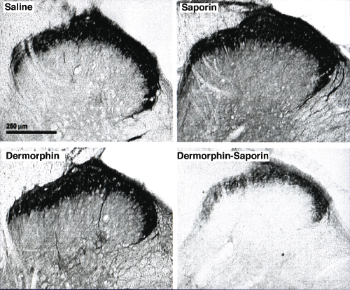Advanced Targeting Systems announces the release of its new, very exciting targeted toxin, dermorphin-SAP. It is a conjugate of the mu opioid receptor (MOR) agonist dermorphin and the ribosome-inactivating protein, saporin. Its cytotoxicity to cells that express the MOR promise to make it an important tool in the discovery and definition of the role of these cells in many biological processes.
In the latest issue of the Journal of Neuroscience, Porreca et al. (1) use this molecule for an important characterization of the descending pain pathways and the possible role of “ON” cells, the MOR-expressing cells of the rostroventromedial medulla (RVM), in the processes of chronic pain models. They injected dermorphin-SAP into the RVM and demonstrated loss of MOR-expressing cells near the injection site (Fig. 1). These neurons project to the spinal cord and it has been suggested by Howard Fields that they are responsible for a tonic discharge that mediates descending facilitation of nerve injury-induced pain. In fact, Porreca et al. demonstrate that with the loss of these cells, the expression of experimental neuropathic pain is ablated. This striking demonstration of supraspinal neurons having such a powerful effect on spinal cord properties is, well, sensational.

Figures supplied by Drs. Frank Porreca and Josephine Lai
The conjugate is made with dermorphin, first characterized from the skin of Phyllomedusa sauvagei by Montecucchi et al. (2). This agonist has one of the best profiles of specificity for the MOR of any known molecule, with exquisite affinity for the MOR (Fig. 2), while much lower affinity for the delta receptor (3). It has been documented to be internalized upon receptor binding, and with saporin attached takes in the ribosome-inactivating agent, causing protein synthesis inhibition and subsequent cell death. This specific lesioning tool is exemplary of many of Advanced Targeting Systems’ products.
Dermorphin-SAP was developed from a collaboration with Ron Wiley, and a glimpse of the activity of this cytotoxin was published in the journal Neuropeptides (4). MOR-expressing neurons have long been considered some of the most important cells in the nervous systems because of their participation in pain, pain control, addiction, gastrointestinal motility, and mast cell function, among others. This specific cytotoxin provides new methods for understanding these neurons and how they work.

References
- Porreca F, Burgess SE, Gardell LR, Vanderah TW, Malan TP, Jr, Ossipov MH, Lappi DA, Lai J (2001) Inhibition of neuropathic pain by selective ablation of brainstem medullary cells expressing the μ-opioid receptor. J Neurosci 21(14):5281- 5288.
- Montecucchi PC, de Castiglione R, Piani S, Gozzini L, Erspamer V (1981) Amino acid composition and sequence of dermorphin, a novel opiate-like peptide from the skin of Phyllomedusa sauvagei. Int J Pept Prot Res 17(3):275-283.
- Attila M, Salvadori S, Balboni G, Bryant SD, Lazarus LH (1993) Synthesis and receptor binding analysis of dermorphin hepta-, hexa- and pentapeptides. Int J Pept Prot Res 42:550-559.
- Lappi DA, Wiley RG (2000) Entering through the doors of perception: characterization of a highly selective Substance P receptor-targeted toxin. Neuropeptides 34(5):323-328.
Related product information: Dermorphin-SAP (Cat. #IT-12)
